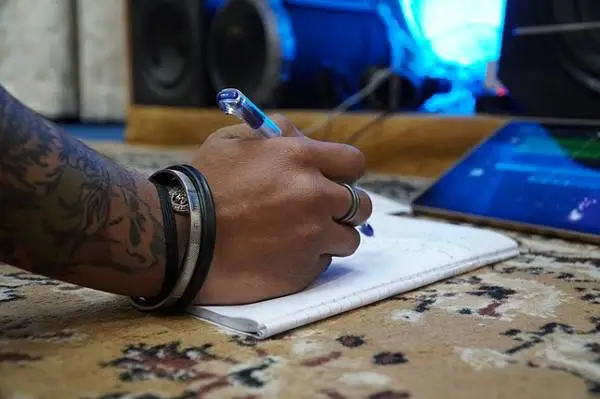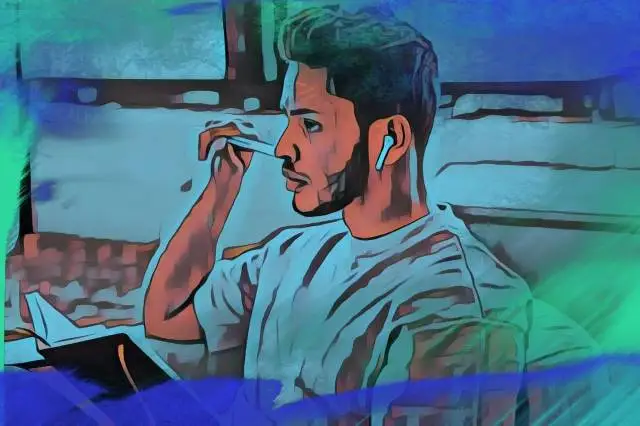Today's popular music is filled with shamelessly catchy melodies, which is likely why toplining has become such an integral occupation in the music industry. However, while some of the best topline writers can write catchy melodies at the drop of a pin, they're also highly creative and expedient when it comes to their work.
Today, we want to focus on toplining as a conceptual approach . Most people have heard the term "toplining," though they're not really sure what it is.
Let's dive in and learn more about what it means to topline so you can determine whether or not it sounds like something that interests you!
What Is Toplining?
When toplining, you write a vocal melody and lyrics over existing music, most likely made by someone else. So in a sense, toplining is a lot like songwriting in that you ARE writing one of the most prominent elements of the song.
However, because you aren't actually developing the song from scratch, we don't refer to it as "traditional songwriting."
If you get hired by someone else to topline a song, you will only be expected to write the lyrics and vocal melody.
Toplining Vs. Songwriting
A topline writer is a bit different from a songwriter in that a songwriter will typically write most of the song, including the lyrics, melody, chords, and song structure. To finalize a song, a songwriter will only need a producer (unless they are one).
On the other hand, topline writers will create melodies and lyrics atop beats or instrumentals created by musicians or producers. This means that the topliner will not have complete creative control over the chord progression or song structure.
Should You Consider Becoming a Topline Writer?
Absolutely!
Becoming a topline writer can be an excellent move for your music career if you like the idea of writing catchy songs with good lyrics. If you feel that your main musical gifts are singing, lyric writing, and melody crafting, becoming a top liner might be right up your alley.

Plus, you can get enough paid work from toplining to live comfortably. Of course, don't expect to live lavishly at first, though with enough clients under your belt and music in your portfolio, you can make it a fulfilling and well-paying career.
Toplining In Today's Music Landscape
Toplining is most prominent in pop, hip-hop, and EDM in today's musical landscape. Typically, a song starts with a beat produced by a producer or musician.
There are many cases where bands, producers, and commercials don't want to write vocal parts for their songs. Some producers are great at creating beats and synth tracks, though when it comes to their lyric writing skills or vocal melodies, they're not as confident. This is where topliners come in.
It's a very prominent profession in today's music industry and something you should definitely consider.
How To Start With Topline Writing
The first thing you will want to do is practice toplining.
If you can't topline or you don't have any toplined tracks in your portfolio, getting a gig is going to be difficult. See if you have any friends with instrumental tracks or demos that you can use to practice writing. You can even find free music beds online!
At this point, you should focus on having fun and seeing how creative you can get with your melodic ideas! But, of course, not every song will be a great song, and that's okay.
Developing your portfolio can take a long time, though the more songs you have, the more beneficial it can be. For example, a songwriter with over 100 songs in their portfolio essentially has an impressive business card to show producers looking for topliners.
PRO TIP: It can be a good idea to topline a single instrumental track with multiple lyric and melody ideas, as it can show clients that you're capable of writing in multiple styles. In doing so, you're more likely to get a paid gig!
Mistakes To Avoid In Topline Writing
Cramming Too Many Ideas Into One Piece of Music
While you can go crazy with ideas when writing songs for your experimental indie project, one of the biggest pitfalls of beginner topliners is adding way too many ideas into one track. Songs that have too many motifs can get confusing for the listener. Plus, too many motifs often dilute the main message.
Of course, the question then becomes,
How do I know if I have too many motifs in one track?
Well, you can start by looking at your chorus . Can you identify more than one hook ? If so, you might want to stop writing and work with what you have. It's a good idea to make sure your melodies are sparse and succinct, as it'll help make your songs catchier.
When it comes to lyrics, it can be a good idea to split up your choruses into shorter phrases, working line by line. You won't often find any more than three to eight words in a line for a pop chorus.
A great example of this is Nelly Furtado's classic, "Promiscuous."
Each phrase has about five words or less, and the melody stays relatively intact with each phrase. This is a chorus that just about anyone and their mother knows and can sing from memory.
No Changes Between Sections
As a topline writer, you're telling a story. It's up to you to take the listener on a journey. This means that your story needs to move and keep the listener engaged.
One of the biggest mistakes topliners make is not having changes throughout their songs. Here's a rule of thumb to consider:
When writing verses and choruses, use the verse to tell your story and keep the melody a bit more relaxed. Then, when the chorus hits, this is where you make your point with a much larger and catchier melody.
Let's look at "Stay" by Post Malone.
The verses are a lot more laid-back, telling the story. However, when the choruses come in, he moves into a higher register and uses a hook melody to give the listener something to hold onto. This big shift is pronounced enough to keep you interested and tell you something bigger is happening.
No Time Management
If you want to be a professional topliner, you will have to practice time management. Toplining requires expediency, as songs are often needed very quickly.
With the undeniable speed of digital content in current trends, people are constantly consuming new material. If you're an artist or writer, you're either continuously creating new music or losing traction. Many professions rely on the expedient topline songwriter to get material out there as often as possible. If your assignment is late, you probably won't get the gig.
Not only is it important to have the fundamental of songwriting, such as chord structure, music theory, lyric writing, and melody writing, under your belt, but it's equally important to have a line of communication with your client.

It's up to YOU to figure out what your clients needs.
What kind of vibe are they going for with the music?
What kind of melodies do they prefer, and what kind of lyrics do they want to convey?
It can be beneficial having references to work off of, as that way, you'll know that you and the client are on similar pages.
Lack of Lyrical Imagery
Regardless of how catchy your melodies are, if your lyrics feel empty , your audience will have a difficult time connecting. Remember, you're a storyteller. You must assume your audience has the imagination to plant vivid imagery in so your lyrics can resonate better.
When Bruno Mars' hit song "Uptown Funk" came out in 2014, everyone knew all of the words. Of course, Bruno Mars has an incredible voice and an obvious swagger that comes through in his music. However, this particular track had so many great lyrics that painted pictures for the audience, giving them something to latch onto.
Who doesn't feel just as gangster as Bruno Mars when they sing the lyrics,
Stop, wait a minute
Fill my cup, put some liquor in it
Take a sip, sign a check
Julio, get the stretch!
How Do Topline Writers Get Paid?
There are several ways in which topliners can get paid. Let's look at a few of the most common ways:
Royalty Split / No Upfront Pay
In this scenario, you won't get paid to topline the song upfront. However, you will get a larger royalty split on the back end, which can be helpful if the song ends up generating some revenue.
Be cautious if you decide to take this route, as there is no guarantee that you will get paid. Of course, if you believe that the client will generate revenue, which will, in turn, deliver substantial royalties to you, then this can be a GREAT route.
Work for Hire
A "work for hire" agreement is very common when it comes to toplining services. Often, a top liner won't be sure whether a song will have success or not, especially if a client does not have proven sales prior. Plus, most musicians want money upfront, and we don't blame them!
Of course, the obvious downside here is that you won't make anything off of the song if it ever takes off. Use your intuition and what you know about the client to determine whether or not this track should be a work for hire or not.
Best of Both Worlds
Sometimes, people hire topliners and give them lower rates upfront with royalties on the backend. In this situation, the royalties will likely be much lower than the standard 50/50, though it can be nice to have a small cushion with up-front pay and potential royalties on the band-end.

Do Topline Writers Get Credited For Their Work?
When you write the top line, you should get songwriting credit. However, just because you've toplined the music does not mean that you have full copyright ownership. The only thing you have copyright for is the melody and lyrics.
It's important to make sure that you speak with your client about this upfront, as the last thing you want is to write a topline for someone, only to find out that they don't credit you when the track is finished, and you didn't sign a contract or agree to any credit before you started the project.
Tips & Tricks For Toplining
Listen Carefully To The Instrumental Track
It's important to take some time and listen to the instrumental you have before you dive in and start writing. Knowing what is happening structurally and dynamically will help you tell a better story and make better melodic choices.
More often than not , you will get instrumental tracks that are structured like typical pop songs: verse, chorus, verse, chorus, bridge, chorus.
However, song structures are incredibly variable today, and there is a chance that the instrumental you have has different parts, such as interludes or pre-choruses.
Once you have a strong sense of the structure of your song, you can begin trying out some melodies.
Understand the Emotion of the Track
One question that is helpful to ask yourself is,
What do I FEEL when listening to this track?
Is it a sad song? How about a joyful song? Maybe it's an angry song?
You want to pull as many "vibes" out of the track as you can, as they'll help you create the best-possible melody and lyrics. Get an idea of what you may want your lyrics to be about. Close your eyes and imagine where the track takes you. Maybe it's to the club, the beach, your backyard, or on a desert road trip.
Once you have a mental image, you can begin sketching out some lyrics. You don't need to finalize your lyrics right away, though it can be helpful to have some ideas to bounce around.
Write With a DAW
A DAW, or Digital Audio Workstation, is a must-have program as a topliner. Some of the most popular DAWs include Pro Tools, Logic Pro X, and Ableton. With a DAW, you can record your topline as you go, moving your vocal lines around from one part to the next.
You can also use a DAW to chop your vocal lines up and fit them together in unique ways that you wouldn't be able to with a raw recording.
There are so many possibilities when you create with a DAW , and most topliners in the industry have one and know how to operate it well.
Keep Your Work Organized
It's a good idea to organize your work by genre, mood, key, or BPM. This way, when a producer asks for work you've already completed to see whether or not they want to hire you, you'll be able to get it to them right away.
Plus, when a producer sends you beats in a certain key, BPM, or genre, you'll have a good idea of what you've done before, allowing you to pull certain ideas from your past work.
Have Quality Demos
It's very important that your topline demos are well-produced. Of course, you don't need to fully mix and master them, though they should be at a high standard. You'll want to record your voice with decent equipment, make sure your vocals are in tune , and make sure your demos aren't painful to listen to.
Giving a producer several songs that were poorly recorded and out of tune can make a bad first impression, and you likely won't get hired.
Network With Producers and Musicians
Start by finding a genre that you feel comfortable writing for. It's crucial to focus on the things you're good at, as you'll often be competing against many topline writers. For example, if your strengths lie in the realm of hip hop, you might want to start there.
There are HUNDREDS of ways to find people to work with. You can start out with producers in your local area or hit up websites like Reddit, where you can find beat-maker communities.
Once you have some traction, you can head to websites like SoundBetter, where you can begin working with higher-end clients.
Becoming a topline writer can be incredibly difficult if you aren't connected with the music community around you. It's a good idea to put yourself in places where you can meet other musicians, including venues, music schools, bars, or networking events.
Conclusion
Are you ready to become a topline songwriter?
Of course, toplining isn't for everyone. Some people like writing from the ground up. You also shouldn't worry that it's taking the place of traditional songwriting, as there are MANY other songwriters out there who do it all. However, we see toplining as a reflection of current technological possibilities. It can be just as fulfilling as writing songs from scratch.
A topliner who can do it right can create catchy songs that can transcend the industry and stand the test of time.





